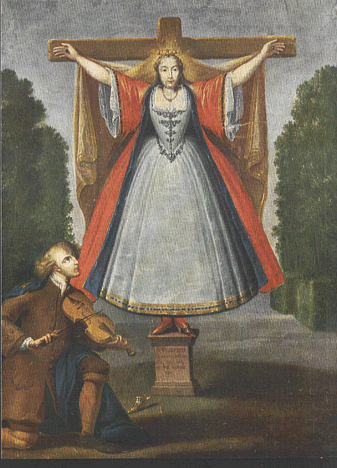 L'accenno italiano ve lho gia dato sulla Heilige Kummernis. ora la citazione inglese spiega una versione simile, a volte con dettagli maggiori.
L'accenno italiano ve lho gia dato sulla Heilige Kummernis. ora la citazione inglese spiega una versione simile, a volte con dettagli maggiori. Mi soffermo su importante particolare di cui non avevo parlato: il famoso e venerato "Volto Santo" di Lucca(foto 1) ha molte caratteristiche che lo riferiscono a quella che viene tradotta in italiano come "Santa Liberata", sebbene "kummer" tradotto voglia dire "affanno" (ma c'e' da dire che a volte è menzionata cme "Ohnkummer" ovvero "senza affanno").
 Il Volto santo ha la veste blu e con cinta d'oro lunga come nelle antiche rappresentazioni della santa. Vestito sontuoso (come lei ricca di famiglia, non certo come gesù in croce), ma un altro particolare su cui ancora devo approfondire ma che ritorna anche nelle rappresentazioni di lei: un semicerchio attorno all'intera figura , che finisce, ai due lati, con dei gigli(foto 2 e 4). In epoca romanica porta la corona.
Il Volto santo ha la veste blu e con cinta d'oro lunga come nelle antiche rappresentazioni della santa. Vestito sontuoso (come lei ricca di famiglia, non certo come gesù in croce), ma un altro particolare su cui ancora devo approfondire ma che ritorna anche nelle rappresentazioni di lei: un semicerchio attorno all'intera figura , che finisce, ai due lati, con dei gigli(foto 2 e 4). In epoca romanica porta la corona.For those who do not know the story, here is the Catholic Encyclopaedia:

[quote]
A fabulous female saint known also as UNCUMBER, KUMMERNIS, KOMINA, COMERA, CUMERANA, HULFE, ONTCOMMENE, ONTCOMMER, DIGNEFORTIS, EUTROPIA, REGINFLEDIS, LIVRADE, LIBERATA, etc.
The legend makes her a Christian daughter of a pagan King of Portugal. In order to keep her vow of chastity, she prayed God to disfigure her body, that she might evade
 the command of her father to marry a pagan prince. God caused a beard to grow on her chin, whereupon her father had her crucified. Connected with this legend is the story
the command of her father to marry a pagan prince. God caused a beard to grow on her chin, whereupon her father had her crucified. Connected with this legend is the story of a destitute fiddler to whom, when he played before her image (or before her crucified body), she gave one of her golden boots. Being condemned to death for the theft of the boot, he was granted his request to play before her a second time, and, in presence of all, she kicked off her other boot, thus establishing his innocence.
The legend is not a Christian adaptation of the Hermaphroditus of Greek mythology or of other androgynous myths of pagan antiquity, as it cannot be traced back further than the fifteenth century. It rather originated from a misinterpretation of the famous "Volto Santo" of Lucca, a representation of the crucified Saviour, clothed in a long tunic, His eyes wide open, His long hair falling over His shoulders, and His head covered with a crown. This crucifix, popularly believed to be the work of Nicodemus, is preserved in the Basilica of Lucca and highly venerated by the people. In the early Middle Ages it was common to represent Christ on the cross clothed in a long tunic, and wearing a royal crown; but since the eleventh century this practice has been discontinued. Thus it happened that copies of the "Volto Santo" of Lucca, spread

pictures of a woman who had suffered martyrdom.
invokes the saint in the hour of death will die ohne Kummer, without anxiety. When the cult of St. Wilgefortis began to spread in the fifteenth and sixteenth centuries, her name found its way into various breviaries and martyrologies. Thus a breviary,

The name Wilgefortis is usually derived from Virgo fortis, but recently Schnürer has shown that Wilgefortis is probably a corruption of Hilge Vartz (Vartz, Fratz, face), "Holy Face". This would corroborate the opinion that the legend originated in the "Volto Santo". The old English name Uncumber, as also the German Oncommer and their equivalents in other languages, rose from the popular belief that every one who



4 commenti:
Petra, ma che stai in crisi mistica..?..no..cosí, chiedo..ciaooooo!
non ci sto...ma ci vorrei stare!
Interessante. Ci sta pure il caso di Santa Filomena, sempre in questo particolare ambito della cosiddetta “religiosità popolare”, tanto “snobbata” talvolta, ma che invece è stata il tramite *storico* che ha permesso la cristianizzazione delle masse rurali. Il santuario, importante, di Santa Filomena, con una raccolta di reliquie di altri santi (anche San Luca Evangelista!) da far invidia, si trova a Mugnano del Cardinale, provincia di Avellino.
Thanks For Sharing his Nice Post.
https://www.upiddu.it/
Posta un commento